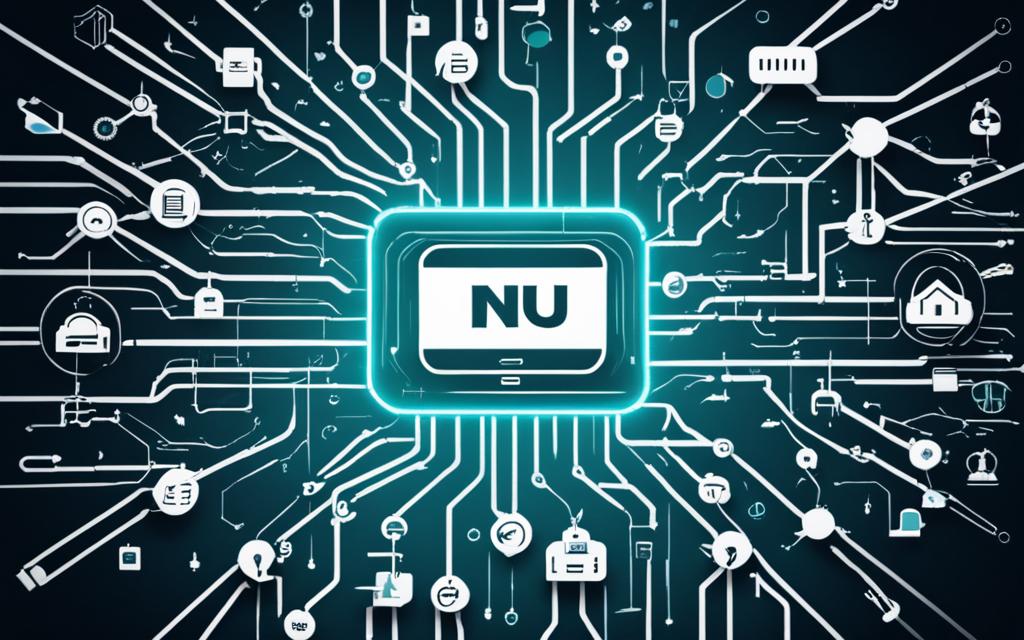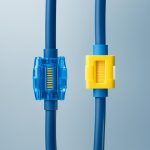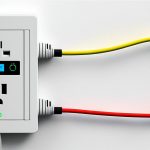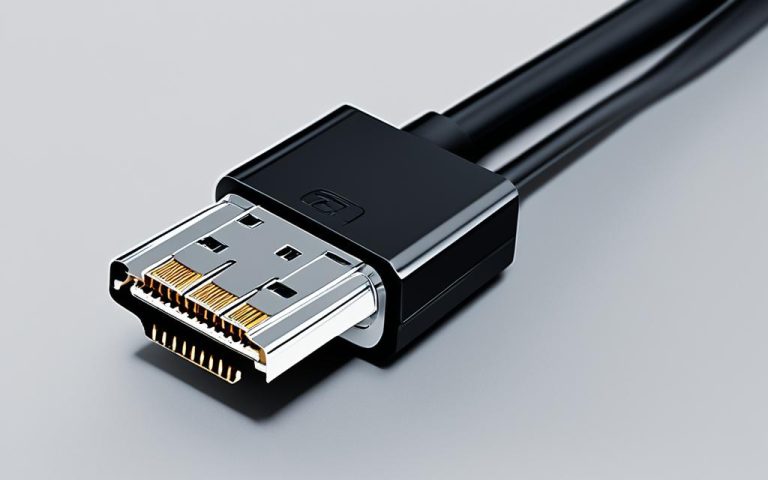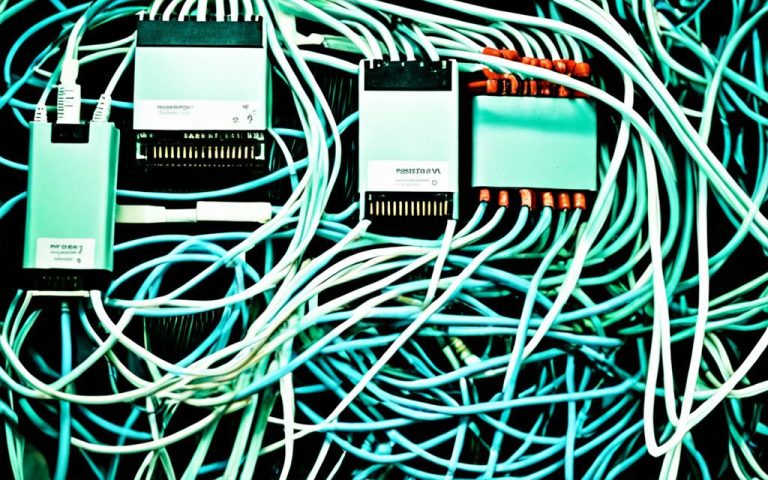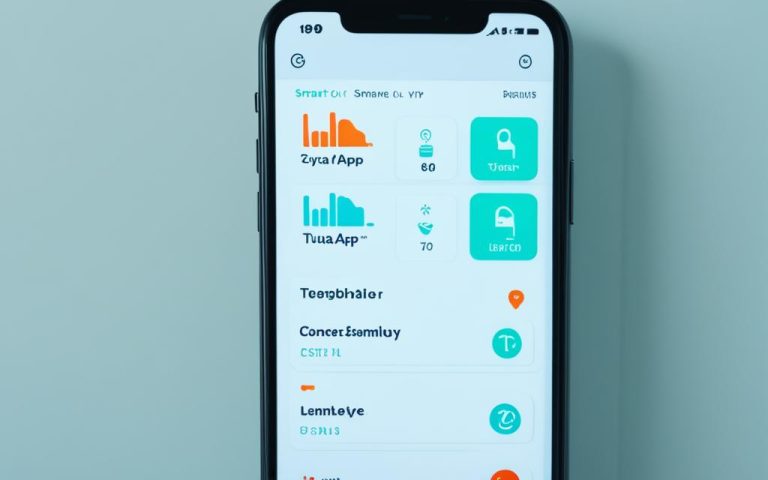A network interface unit (NIU) is a key device in networking. It acts as a bridge for different devices in a local area network (LAN). It also helps computers connect to networks outside their own. This device is often called a network interface card (NIC).
The NIU is vital for networking. It makes sure devices talk to each other smoothly. This boosts the network’s power1.
Key Takeaways:
- A network interface unit (NIU) is a device that serves as a common interface for devices within a network.
- The NIU enables networked computers to connect to outside networks.
- NIUs enhance network capabilities and ensure seamless communication.
- NIUs can be referred to as network interface cards (NICs).
- NIUs are crucial for efficient networking and play a significant role in maintaining network connectivity.
Definition of a Network Interface Unit
A network interface unit (NIU), also known as a network interface card (NIC), connects devices in a local area network (LAN). It lets networked computers join an external network. The NIU is a key point for communication, making sure data moves smoothly between devices.
Unlike routers or switches, the NIU’s main job is to connect devices to the network and manage data flow. It changes digital signals into analog ones for sending over cables or wirelessly.
The NIU is vital for networking by linking devices and networks together. It lets computers, servers, printers, and other devices share data and resources. Without an NIU, devices can’t join the network or exchange data.
There are many types of NIUs, like Ethernet, wireless, fiber optic, and USB NICs. Each type has special features for different network needs.
Ethernet NICs
Ethernet NICs are the most common and used in wired LANs. They support speeds from 10 Mbps to 1 gigabit per second for fast data transfer. Ethernet NICs use unique MAC addresses to send Ethernet packets and connect to the network.[2]
Wireless NICs
Wireless NICs use radio waves for Wi-Fi connections. They let devices connect to wireless routers or access points without cables. This makes wireless NICs great for devices that need to be mobile.[2]
Fiber Optic NICs
Fiber optic NICs handle high-speed network traffic on servers. They use fiber optic cables for better bandwidth and longer distances. Fiber optic NICs are faster but also more expensive and complex than other NICs.[2]
USB NICs
USB NICs connect devices to the network through a USB port, offering flexibility. They’re useful when devices don’t have built-in network interfaces or need extra connections. USB NICs are easy to use and can be plugged in or out as needed.[2]
Network interface units are crucial for networking. They help devices connect and communicate within and across networks. They ensure data moves smoothly and are key to setting up and keeping network connections.
Role of NIU in Networking
The NIU, or Network Interface Unit, is key in networking. It connects devices in a Local Area Network (LAN). It lets devices talk to each other and share data. The NIU makes sure devices can communicate well, making the network stronger.
Devices connect to the NIU to join the network. At NIU, students, staff, and faculty can register up to five devices on the MyDevices Portal3. This lets them use the network for school and personal stuff.
The NIU also links networked computers to the internet. This lets users talk to others online, get to online resources, and work with people and groups around the world. It helps them reach more people and improve their networking.
The NIU is also important for keeping the network safe and running well. If a device hasn’t been used in 180 days, it might lose its network access3. This keeps the network fast and safe from threats.
Guests at NIU can use the ‘NIUvisitor’ Wi-Fi for five days after signing up3. This makes it easy for visitors to stay online and use network services while they’re there.
NIU Managed Devices need to be registered every year. They get cleared on July 31 and need to be registered again from August 13. This keeps the network current and free from old or unused devices.
Visiting faculty and students from other schools can use the ‘eduroam’ Wi-Fi easily with their school login3. This makes it simple for them to use the network and stay connected while they’re at NIU.
In short, the NIU is a key part of networking. It connects devices in a LAN, links to the internet, and keeps the network safe and running well. It’s vital for better connectivity, teamwork, and smooth data flow within and outside the network.
Significance of NIU for Seamless Communication
The Network Interface Unit (NIU) is key for smooth communication in networks. It connects the service provider’s network with the customer’s, making sure devices talk to each other well. This lets computers connect to the outside world, making sharing information easy and smooth.
NIU makes sure networks work well and data moves fast. This is crucial for clear communication across the network.
Smart Jacks inside the NIU help keep services reliable. They can check and fix problems from afar. This means less time without service and better reliability4.
NIU also marks where the service provider ends and the customer begins. This avoids arguments over who fixes what. Problems up to the NIU are the service provider’s job, and after that, the customer’s4. This makes fixing issues faster and keeps communication smooth.
CSU/DSU units make WAN connections more reliable. They handle the technical parts of T1 and T3 lines, making sure they work well and don’t break easily4.
For good communication, knowing how the WAN connection is doing is key. Smart Jacks in the NIU let service providers check the connection’s quality. This helps them keep the network running smoothly4.
The NIU is vital for smooth communication in networks. It helps devices talk to each other, keeps services reliable, and makes problems clear. Its role is big in making networks work better and improving user experience.
NIU’s Impact on Network Capabilities
The Network Interface Unit (NIU) is key to improving network connections. It acts as a bridge, letting devices connect with other networks easily. This makes communication across networks smooth.
NIU broadens the network’s reach and what it can do. It opens up new chances for working together and sharing data. This helps organizations use their networks fully and innovate more.
Experts say Cable Modem services could make $11.9 billion to $26 billion by 20035. Cable phones were set to have 9 million users, making about $4 billion more5. By 2003, Cable video services were expected to hit $38 billion5.
NIU also helps small companies compete in the market. It’s cheaper than traditional phone systems, making it easier for new players to join5. This competition drives new ideas and keeps prices down.
NIU also makes networks use less power. Operators want NIUs to use 5 watts or less, sometimes just 3 watts5. This is important because power costs add up with many NIUs.
The NIU’s role in networking is huge. It connects networks, boosts their power, and saves energy. It’s a key part of today’s networking world.
Network Interface Device vs. Network Interface Unit
The terms “network interface device” (NID) and “network interface unit” (NIU) are often used together, but they mean slightly different things1. The NIU connects devices in a LAN or lets computers join an external network. On the other hand, the NID marks where the carrier’s network ends and the customer’s wiring begins1. It gives access to the wiring and is a spot for checking the network loop1.
Knowing the difference between a network interface device and a network interface unit is key in networking. They both are important for smooth communication but serve different purposes.
Wiring Termination in Network Interface Units
Network interface units (NIUs) have wiring termination features. They have special terminals for connecting phone lines from the service provider and the customer’s wiring. The NIU marks the spot where the phone company’s equipment meets the customer’s. It has a test jack for customers to check if wiring problems are on their side or with the service provider6.
Wiring in NIUs makes sure signals move smoothly from the phone company to the customer’s place. The terminals connect securely, keeping signals strong and clear. This is key for good voice and data over phone lines6.
Benefits of Proper Wiring Termination in NIUs
Right wiring in NIUs brings many benefits. It keeps signals strong and clear, making calls clear and without drops. This means better communication for customers6.
It also stops cross-talk and interference, which is important in places with lots of electrical noise. Correct wiring in NIUs keeps signals clean and reliable6.
Lastly, wiring termination helps with fixing and keeping the network running well. NIUs make it easy to find and fix wiring issues. If a problem stays, it might be with the service provider’s gear. If it goes away, it’s likely a customer wiring issue. This saves time and effort in solving network problems6.
Choosing the Right Wiring Termination
Choosing the right wiring for NIUs depends on several things. The cable type, data needs, and network setup matter. Knowing about different cables and their abilities is key to making a good choice7.
CAT3, CAT5, and CAT6 UTP cables are often used in networks. They support different bandwidths, from 10 Mbps to 1 Gbps. Coaxial cables are good for things like TV and computer networks, and they send signals well over short distances. Optical fiber cables are for high-speed needs, handling up to 100 Gbps and resisting electrical noise well7.
It’s also important to look at what the network interface units can do. Different NIUs have different features like how many I/O modules they support and how much memory they have. For example, the Ethernet Network Interface Unit (IC200EBI001) works with VersaMax I/O modules and holds a lot of data. Knowing these details helps match the NIUs with the network needs8.
Smartjacks in Network Interface Units
Smartjacks are key in network interface units (NIUs). They do more than just connect wires. They bring advanced features to the table.
These smart devices change signals, fix signal loss, and help diagnose problems9. They’re used in services like T1 lines and triple play services10.
“Smartjacks are more than just a wiring termination point. They are the backbone of seamless communication, offering features like loopback testing, alarm indication signals, and configuration indicator lights9.”
Smartjacks have a box with lights, a circuit board, an RJ45 jack, and a cable11. They change 2 pair lines to RJ45 T1 or PRI lines. Sometimes, a CSU/DSU is needed for extra translation11.
These devices sit in main phone rooms and connect to office suites with cables11. They keep circuits working even if the cord is pulled out11.
Signal strength for T-1 lines is crucial and can be adjusted at different points11. NIUs, or smart jacks, are key for checking signals, showing line status, and keeping track of problems11.
Modern T1-NIUs track performance and spot issues like signal loss and errors11. They alert the network to problems and support alarms for faults11.
Optical Network Terminals in Network Interface Units
In fiber-to-the-premises systems, network interface units (NIUs) are key for smooth communication. They often have optical network terminals (ONTs) or optical network units (ONUs). These devices end the fiber optic line and offer many features to boost connectivity.
ONTs/ONUs work in active and passive optical networks. Their main job is to split the signal into different parts and give power to customer phones. They link the fiber optic network to the customer’s place, making sure voice, TV, and internet signals get through.
These devices can work in different modes, like modem/bridge mode or router mode. This lets networks be customized for various needs.
“ONTs/ONUs ensure the efficient transmission of voice, television, and internet access signals to customer premises.”
Using ONTs/ONUs in NIUs boosts network speed, makes phone services reliable, and brings better TV features. These devices manage voice, video, and data traffic well, giving users a smooth experience.
ONTs/ONUs in NIUs make it easy to get voice, video, and internet services through one connection. This makes things simpler for customers, cutting down on the need for many devices and complicated setups.
Adding ONTs/ONUs to NIUs makes the network more efficient and reliable. These devices have advanced features like quality of service (QoS) management and error correction. This helps improve network performance.
Also, ONTs/ONUs have security features to protect customer data and keep it private. They use encryption and authentication to keep network communications safe from threats.
In summary, having optical network terminals in network interface units is crucial for fiber-to-the-premises systems. These devices make connectivity efficient and versatile. They enhance network capabilities and give customers reliable and high-quality communication services.
| Statistical Data | Reference Number |
|---|---|
| Percentage of GFiber customers connected to the GFiber network within a particular area during the build-out process | 12 |
| Frequency of DHCP usage in configuring devices connected to the network | 12 |
| Number of homes or buildings where the Fiber Drop connects to the Network Interface Unit (NIU) | 12 |
| Percentage of multi-family dwelling units (MDU) with Network Interface Units installed | 12 |
| Occurrence rate of power cycling to resolve network connectivity issues or hardware malfunctions | 12 |
| Ratio of SSID usage for wireless local area networks (WLAN) communication | 12 |
| Comparative analysis between the usage rates of WPA and WPA2 security modes for Wi-Fi networks | 12 |
| Weatherproofing for NID is classified into three categories by Telcordia GR-49: normal, severe, and flooded conditions | 13 |
| Common names for NIDs within the United States include Network Interface Unit (NIU), System Network Interface (SNI), Telephone Network Interface (TNI), and Telephone Network Box | 13 |
| ONTs use fiber optic cabling and do not provide power. They need an external power source and backup batteries for power outages | 13 |
| T1 service can support up to 28 digital voice lines or 48 VoIP lines and carry up to 1.5 Mb of bandwidth | 13 |
| The maximum distance of T1 lines is 655 feet (200 meters) past the demarc | 13 |
| Multiple applications are planned for the OBCS, including integrating computers and computer devices at the University of California San Francisco Hospitals and Clinics | 14 |
| The OBCS uses a contention bus topology for communication, employing Carrier Sense Multiple Access with Collision Detection (CSMA/CD) to ensure efficient data transfer | 14 |
| Communication functions in the OBCS are governed by protocols performed within NIUs, simplifying development and maintenance activities | 14 |
Conclusion
Network interface units (NIUs) are key in networking. They connect devices in a LAN and link them to the outside world. NIUs make sure communication flows smoothly and help networks work better.
Smartjacks and optical network terminals add more to the network. They change signals, help diagnose problems, and send data through fiber optics. These tools make networks more powerful and improve how we communicate.
Understanding NIUs is important because they are crucial for networking’s full potential. By using NIUs, companies can send data faster, improve communication, and have a strong, reliable network.
To learn more about NIUs, check out NIU’s privacy policy for info on protecting data and accessing it[^1]. See the perks of in-person and online networking events for students [^2]. Or, take online courses to get better at wireless networking [^3]. NIUs can open up a world of easy and efficient communication.
NIU’s privacy policy,in-person and virtual networking eventsfor,wireless networking online courses151617.
FAQ
What is a network interface unit (NIU) and what is its purpose in networking?
A network interface unit (NIU) is a device that connects different devices in a local area network (LAN). It helps devices talk to each other and connect to outside networks. This makes networking smoother and improves network performance.
How does a network interface unit (NIU) enhance communication capabilities?
The NIU makes sure devices in a network can communicate well by offering a common interface. It helps send data smoothly between devices, making data transfer fast and network performance steady. It also lets computers connect to other networks, making communication wider and more effective.
What impact does a network interface unit (NIU) have on network capabilities?
The NIU greatly boosts network capabilities. It connects devices to outside networks, making the network more powerful. This lets computers use resources and services from other networks, improving network functions. It also makes the network better at sharing data and working with others.
What is the difference between a network interface device (NID) and a network interface unit (NIU)?
“Network interface device” (NID) and “network interface unit” (NIU) are often used together, but they’re not exactly the same. The NIU connects devices in a LAN or links networked computers to outside networks. The NID marks the spot where the carrier’s network meets the customer’s wiring, acting as a test point.
Do network interface units (NIUs) include wiring termination capabilities?
Yes, NIUs often have wiring termination features. They have special terminals for connecting phone lines from the provider to the customer’s wiring. The NIU is where the phone company’s equipment meets the customer’s, serving as a test point for wiring issues.
What are smartjacks and how are they related to network interface units (NIUs)?
Some NIUs have smartjacks, which are smart network devices. Smartjacks do more than just connect wires. They improve signals, fix signal problems, and help diagnose issues. They also have features like loopback testing and lights to show their status, and they get power from the phone line.
What are optical network terminals (ONTs) and how are they used in network interface units (NIUs)?
In fiber systems, NIUs might have optical network terminals (ONTs) or units (ONUs). These devices end the fiber line, break down the signal, and power customer phones. ONTs/ONUs work in different networks and can be in modem or router mode. They send signals for voice, TV, and internet to homes efficiently.
Source Links
- https://en.wikipedia.org/wiki/Network_interface_device – Network interface device
- https://www.techtarget.com/searchnetworking/definition/network-interface-card – What is a network interface card (NIC)? Definition from SearchNetworking
- https://www.niu.edu/doit/services/network/wi-fi.shtml – NIU Wi-Fi
- https://library.mosse-institute.com/articles/2023/09/wan-terminations.html – WAN: Terminations
- https://www.nctatechnicalpapers.com/Paper/2000/2000-network-interface-unit-a-broadband-gateway-into-the-home/download – Network Interface Unit, A Broadband Gateway into the Home
- https://www.slideshare.net/slideshow/networking-concepts-11983874/11983874 – Networking concepts
- https://stlawrencehighschool.edu.in/uploads/onlineclass/464cd7590ca8ace1394fa61b5e6751f9.pdf – PDF
- https://www.astor.com.pl/wsparcie/dokumentacja-techniczna/pobierz/GE/Sterowniki PLC/VersaMax/Podręczniki/gfk1860a.pdf – VersaMax System Ethernet Network Interface Unit, GFK-1860A
- https://www.professormesser.com/professor-messer-archives/n10-007/wan-termination/ – WAN Termination – CompTIA Network+ N10-007 – 2.5 – Professor Messer IT Certification Training Courses
- https://www.inc-installs.com/tag/smartjack – smartjack Archives – INC Installs – National or Local IT Rollouts and Installation Services
- https://atcomsystems.ca/forum/ubbthreads.php/topics/259499/smart-jack-or-not-to-smart-jack – Smart Jack or not to Smart Jack?
- https://support.google.com/fiber/answer/2459331?hl=en – Glossary of terms – Google Fiber Help
- https://www.inc-installs.com/communications/demarcation-point-demarc – Demarcation Point (Demarc) – INC Installs – National or Local IT Rollouts and Installation Services
- https://www.jhuapl.edu/content/techdigest/pdf/V02-N02/02-02-Healy.pdf – A FIBER-OPTIC LOCAL AREA COMMUNICATIONS NETWORK
- https://www.niu.edu/policies/policy-documents/privacy-in-the-electronic-environment.shtml – Privacy Policy – Privacy in the Electronic Environment – NIU – Policy Library
- https://edsystemsniu.org/in-person-vs-virtual-networking-events-for-students/ – In-Person vs. Virtual Networking Events for Students – Education Systems Center at NIU
- https://www.ed2go.com/niu/online-courses/wireless-networking-self-paced-tutorial/ – Wireless Networking (Self-Guided)

